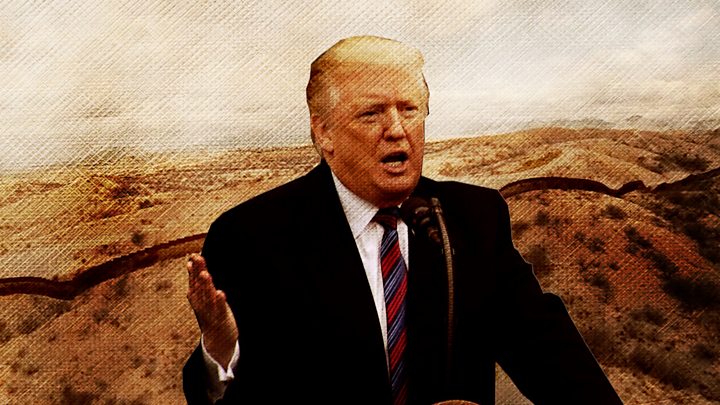How emergency powers could be used to build Trump’s wall
US President Donald Trump plans to make use of emergency powers to secure funding for his proposed US-Mexico border wall.
Invoking a national emergency could enable Mr Trump to bypass Congress and access military funds and resources. But what are these emergency powers, and is using them that simple?
What exactly is a state of emergency?
A state of emergency is usually declared in times of national crisis. In this case, Mr Trump has claimed there is a migration crisis on the US-Mexico border.
Declaring a national emergency gives the president “access to special powers that are contained in more than 100 other laws”, said Elizabeth Goitein, co-director of the Brennan Center’s Liberty and National Security Program.
Those powers effectively allow the president to bypass the usual political process.
“Obviously, the intent is to provide for badly needed flexibility when there are urgent crises which Congress does not have time to address,” Ms Goitein said.
Is there really a border emergency?
More than 2,000 people were turned away or arrested at the border each day during November 2018. Supporters of Mr Trump’s plans for a wall have said the numbers constitute an emergency.
Others argue the migration across the southern border is far lower than a decade ago, and many of the thousands of people who travelled north from countries like Honduras are presenting themselves as asylum seekers, looking to enter the country legally.
Ms Goitein, an expert on presidential emergency powers, said she did not believe the situation constituted a national emergency.
“It needs to be something fast-moving, totally unforeseen, it is meant to be a stopgap measure,” she said. “This is not such a thing and it would be a tremendous abuse of power to invoke just to short-circuit the political process.”
Ms Goitein pointed to two sections of the law which Mr Trump could take advantage of. One would allow the redirection of funds for military projects already approved by Congress, the other would require the administration to prove the wall amounts to a military construction.
Neither are a “slam dunk” for the president, who must cite one of the laws as the legal basis for his declaration, Ms Goitein said.
Can Congress block a national emergency?
The National Emergencies Act contains a clause that allows Congress to terminate the emergency status – provided both houses agree and the president does not veto.
With a comfortable majority in the House, Democrats could pass such a resolution to the Senate. The Republicans control the Senate, but a number of Republican senators have been vocal in their unease about the president invoking a national emergency.
The dissenting Republicans include 2012 presidential candidate and new senator for Utah Mitt Romney, the Florida senator Marco Rubio, and the senator from Alaska Lisa Murkowski, who said the move was “of dubious constitutionality”.
The resolution would however still require Mr Trump’s signature to pass, allowing him to veto it. A supermajority in both houses of Congress is needed to overturn a presidential veto.
There is another option of blocking the move through the courts – which is what happened when President Harry Truman tried to nationalise the steel industry during the Korean War, setting a legal precedent.
“If Harry Truman couldn’t nationalise the steel industry during wartime, this president doesn’t have the power to declare an emergency and build a multibillion-dollar wall on the border,” Adam Schiff, the House intelligence committee chairman, told CNN.
How frequently do presidents use the emergency act?
Mr Trump’s predecessor, Barack Obama, used it 13 times, while his predecessor George W Bush used it 12 times. If Mr Trump goes ahead with declaring a national emergency, it would be the fourth of his administration.
But emergency declarations by previous presidents have been overwhelmingly used for addressing foreign policy crises – including blocking terrorism-linked entities from accessing funds or prohibiting investment in nations associated with human rights abuses.
“It’s extremely rare for a president to declare a national emergency in a bid to fund domestic construction projects, particularly one that Congress has explicitly refused to fund,” Andrew Boyle, an attorney in the national security program at the Brennan Center for Justice, told the Associated Press news agency. “The ones that former presidents declared are of a different sort.”
Mr Trump’s decision to apply the powers to overcome a partisan impasse over border security has struck politicians on both sides of the aisle as a deviation from the intended use of the act.
“It would be a pretty dramatic expansion of how this was used in the past,” said the Republican senator Ron Johnson.
Some previous uses were for issues like the H1N1 influenza epidemic and have since ended. Others are more general and continue to this day, like blocking the property of people “engaging in significant malicious cyber-enabled activities”.
Perhaps the most well-known occasion a president used his powers was in the case of Franklin D Roosevelt, who used them to order the internment of more than 110,000 Japanese-Americans in the months after the 1941 attack on Pearl Harbour.
George W Bush used emergency powers in the wake of the 11 September 2001 World Trade Centre attack to sign off wiretapping and interrogation methods later decried as torture.
The National Emergencies Act is not used to respond natural disasters.
Source: Read Full Article



